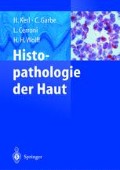Zusammenfassung
Im formalinfixierten, in Paraffin eingebetteten Gewebe hängt der Erfolg immunhistochemischer Färbungen von verschiedenen Bedingungen ab:
-
Die nachzuweisenden antigenen Determinanten (Epitope) müssen die Formalinfixierung und den nachfolgenden Einbettungsvorgang unbeschadet überstehen oder sie sollten nach fixierungsbedingter Alteration ihrer tertiären Proteinstruktur rekonstituierbar sein (Antigendemaskierung).
-
Erforderlich sind Antikörper, die sich auch im fixierten Gewebe spezifisch an Epitope binden können.
-
Zum Nachweis der spezifischen Antikörperbindung sind sensitive Detektionssysteme notwendig, die lichtmikroskopisch erkennbare, permanente Farbsignale geben.
Access this chapter
Tax calculation will be finalised at checkout
Purchases are for personal use only
Preview
Unable to display preview. Download preview PDF.
Literatur
Boenisch T (1999) Diluent buffer ions and pH: Their influence on the performance of monclonal antibodies in immunohistochemistry. Appl Immunohistochem Molecul Morphol 7: 300–306
Bourne JA (1983) Handbuch I der Immunperoxidase Färbemetho den. DAKO, Hamburg
Bullock GR, Petrusz P (eds) ( 1982, 1983, 1985) Techniques in immunocytochemistry, vol 1, 2, 3. Academic Press, London
Chan JKC (1998) Advances in immunohistochemical techniques: Toward making things simpler, cheaper, more sensitive, and more reproducible. Adv Anatomic Pathol 5: 314–325
Chaubert P, Bertholet MM, Correvon M, Laurini S, Bosman FT (1997) Simultaneous double immunoenzymatic labeling: A new procedure for the histopathologic routine. Mod Pathol lo: 585–591
De Bruijn EMCA (1992) Formaldehyde fixation in histochemistry. Histochem J 24: 493
DeiTos AP, DalCin P (1997) The role of cytogenetics in the classification of soft tissue tumours. Virchows Arch 431: 83–94
Fletcher JA (1997) Cytogenetics of soft tissue tumors. In: Verweij J, Pinedo HM, Siut HD (eds) Soft tissue sarcomas: Present achievements and future prospects. Kluver Academic Publishers, Boston, pp 9–29
Javois LC (ed) (1994) Immunocytochemical methods and protocols. Methods in molecular biology, vol 34. Humana Press, Totowa
Larsson LI (1993) Tissue preparation methods for light microscopic immunohistochemistry. Appl Immunohistochem 1: 2–16
Leong SY, Milios J, Leong FJ (1996) Epitope retrieval with microwaves. A comparison of citrate buffer and EDTA with three commercial retrieval solutions. Appl Immunohistochem 4: 201–207
McNicol AM, Richmond JA (1998) Optimizing immunohistochemistry: Antigen retrieval and signal amplification. Histopathology 32: 97–103
Murray PG, Ambinder RF (1994) In situ hybridization in relation to infectious agents. In: Crocker J (ed) Molecular biology in histopathology. John Wiley and Sons, New York, pp 1–14
Myers JA, Mehta P, Hunter AW, Bernstein SA, Erickson PA (1995) Automated double-label immunohistochemistry. J Surg Pathol 1: 105–113
Naish SJ (Hrsg) (1989) Handbuch II immunchemischer Färbemethoden. DAKO, Hamburg
Penschow JD (1994) Hybridization histochemistry. In: Woods AE, Ellis RC (eds) Laboratory histopathology. A complete reference. Churchill Livingstone, Edinburgh, 8.6/1–36
Prasad ML, Hyjek E, Giri DD, Ying L, O’Leary JJ, Hoda SA (1999) Double immunolabeling with cytokeratin and smooth-muscle actin in confirming early invasive carcinoma of breast. Am J Surg Pathol 23: 176–181
Pujic Z, Savage NW, Bartold PM, Walsh LJ (1998) Simultaneous detection of multiple antigens with triple immunolabeling. Appl Immunohistochem 6: 150–153
Vyberg M, Nielsen S (1998) Dextran polymer conjugate two-step visualization system for immunohistochemistry. A comparison of EnVision+ with two three-step avidinbiotin techniques. Appl Immunohistochem 6: 3-lo
Wolman SR (1994) Fluorescence in situ hybridization: A new tool for the pathologist. Hum Pathol 25: 586–590
Xue Y, Lange W, Smedts F, Debruyne F, de la Rosette J, Schalken J, Verhofstad A (1998) A novel immunoenzymatic technique to demonstrate multiple antigens in cells based on selective destaining of substrate deposits and its application in characterizing the immunophenotype of neuroendocrine cells in the human prostate epithelium. Appl Immunohistochem 6: 69–76
Editor information
Editors and Affiliations
Rights and permissions
Copyright information
© 2003 Springer-Verlag Berlin Heidelberg
About this chapter
Cite this chapter
Kutzner, H., Palmedo, G. (2003). Immunhistologische Techniken. In: Kerl, H., Garbe, C., Cerroni, L., Wolff, H.H. (eds) Histopathologie der Haut. Springer, Berlin, Heidelberg. https://doi.org/10.1007/978-3-662-07784-9_2
Download citation
DOI: https://doi.org/10.1007/978-3-662-07784-9_2
Publisher Name: Springer, Berlin, Heidelberg
Print ISBN: 978-3-662-07785-6
Online ISBN: 978-3-662-07784-9
eBook Packages: Springer Book Archive

